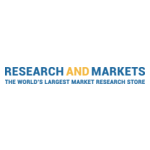DUBLIN–(BUSINESS WIRE)–The “Chemical Fertilizers Global Market Report 2022” report has been added to ResearchAndMarkets.com’s offering.
The global chemical fertilizers market is expected to grow from $146.7 billion in 2021 to $160.15 billion in 2022 at a compound annual growth rate (CAGR) of 9.2%. The market is expected to grow to $223.74 billion in 2026 at a CAGR of 8.7%.
Major companies in the chemical fertilizers market include Sinopec Limited, Yara International ASA (ADR), Guardian Industries LLC, Nutrien Ltd, Marubeni, Mitsui, BASF SE, CF Industries Holdings Inc, Israel Corp Ltd, and Sinofert Holdings Limited.
The chemical fertilizers market consists of the sales of fertilizers by entities (organizations, sole traders, or partnerships) that produce nitrogenous or phosphatic fertilizer materials, produce fertilizers from sewage or animal waste, manufacture nitrogenous or phosphatic materials and mix with other ingredients into fertilizers, and/or mix ingredients made elsewhere into fertilizers.
The main types of chemical fertilizers are nitrogen fertilizer, phosphate fertilizer, and potash fertilizer. Nitrogen fertilizer is a substance, like manure or a mixture of nitrates, added to soil or water to increase its productivity. The crop categories are cereals, oilseeds, vegetables, fruits, and other crop categories. The forms are solid, liquid, and gaseous. The product types are complex fertilizers, dap, mop, urea, ssp, and other product types. The methods of application are broadcasting, drop spreading, fertigation, and foliar spray.
Asia Pacific was the largest region in the chemical fertilizers market in 2021. North America was the second-largest region in the chemical fertilizers market. The regions covered in the chemical fertilizers report are Asia-Pacific, Western Europe, Eastern Europe, North America, South America, Middle East, and Africa.
Farmers all around the world are adopting intensive farming techniques to increase productivity per hectare. Intensive farming is an agricultural intensification and mechanization system that aims to maximize yields from available land through various means, such as heavy use of pesticides and chemical fertilizers.
These techniques help to meet the rising demand for food of the growing population and help to prevent food shortages. Some intensive farming techniques, such as monoculture, drive the demand for fertilizers. Monoculture is a practice of growing one type of crop intensively over a large area, thus depleting nutrients in the soil and making it heavily dependent on synthetic fertilizers.
The fertilizers market is likely to be affected by the rising use of bio-fertilizers due to the adverse impact of synthetic fertilizers on soil and other environmental concerns. A bio-fertilizers contains living microorganisms such as bacteria, fungi, and algae, which are capable of fixing atmospheric nitrogen or converting soluble phosphate and potash in the soil into forms available to the plants. Bio-fertilizers promote growth in plants by increasing the supply or availability of primary nutrients to the host plant. The use of bio-fertilizers was further augmented by the negative impacts of prolonged use of chemical fertilizers on the soil.
Phosphorus is being recovered from sewage, manure, and other sources and made available as a fertilizer. Since phosphorus is a finite source, companies are looking for ways to recycle or recapture phosphorus to be used in agriculture.
Plant-available phosphorus content is increased through anaerobic digestion and composting and in sludge from sewage through acid treatment and oxidizing. According to research conducted by the Luke Research Agency, Finland, manure, and sludge when treated appropriately can provide more phosphorus than traditional inorganic fertilizers.
Key Topics Covered:
1. Executive Summary
2. Report Structure
3. Chemical Fertilizers Market Characteristics
3.1. Market Definition
3.2. Key Segmentations
4. Chemical Fertilizers Market Product Analysis
4.1. Leading Products/ Services
4.2. Key Features and Differentiators
4.3. Development Products
5. Chemical Fertilizers Market Supply Chain
5.1. Supply Chain
5.2. Distribution
5.3. End Customers
6. Chemical Fertilizers Market Customer Information
6.1. Customer Preferences
6.2. End Use Market Size and Growth
7. Chemical Fertilizers Market Trends And Strategies
8. Impact Of COVID-19 On Chemical Fertilizers
9. Chemical Fertilizers Market Size And Growth
9.1. Market Size
9.2. Historic Market Growth, Value ($ Billion)
9.2.1. Drivers Of The Market
9.2.2. Restraints On The Market
9.3. Forecast Market Growth, Value ($ Billion)
9.3.1. Drivers Of The Market
9.3.2. Restraints On The Market
10. Chemical Fertilizers Market Regional Analysis
10.1. Global Chemical Fertilizers Market, 2021, By Region, Value ($ Billion)
10.2. Global Chemical Fertilizers Market, 2016-2021, 2021-2026F, 2031F, Historic And Forecast, By Region
10.3. Global Chemical Fertilizers Market, Growth And Market Share Comparison, By Region
11. Chemical Fertilizers Market Segmentation
11.1. Global Chemical Fertilizers Market, Segmentation By Type, Historic and Forecast, 2016-2021, 2021-2026F, 2031F, $ Billion
- Nitrogen Fertilizer
- Phosphate Fertilizer
- Potash Fertilizer
11.2. Global Chemical Fertilizers Market, Segmentation By Crop Category, Historic and Forecast, 2016-2021, 2021-2026F, 2031F, $ Billion
- Cereals
- Oilseeds
- Vegetables
- Fruits
- Other Crop Categories
11.3. Global Chemical Fertilizers Market, Segmentation By Method of Application, Historic and Forecast, 2016-2021, 2021-2026F, 2031F, $ Billion
- Broadcasting
- Drop Spreading
- Fertigation
- Foilar Spray
11.4. Global Chemical Fertilizers Market, Segmentation By Form, Historic and Forecast, 2016-2021, 2021-2026F, 2031F, $ Billion
- Solid
- Liquid
- Gaseous
11.5. Global Chemical Fertilizers Market, Segmentation By Product Type, Historic and Forecast, 2016-2021, 2021-2026F, 2031F, $ Billion
- Complex Fertilizers
- DAP
- MOP
- Urea
- SSP
- Other Product Types
12. Chemical Fertilizers Market Metrics
12.1. Chemical Fertilizers Market Size, Percentage Of GDP, 2016-2026, Global
12.2. Per Capita Average Chemical Fertilizers Market Expenditure, 2016-2026, Global
Companies Mentioned
- Sinopec Limited
- Yara International ASA (ADR)
- Guardian Industries LLC
- Nutrien Ltd.
- Marubeni
- Mitsui
- BASF SE
- CF Industries Holdings Inc.
- Israel Corp. Ltd.
- Sinofert Holdings Limited
For more information about this report visit https://www.researchandmarkets.com/r/cr9lu1
Contacts
ResearchAndMarkets.com
Laura Wood, Senior Press Manager
[email protected]
For E.S.T Office Hours Call 1-917-300-0470
For U.S./CAN Toll Free Call 1-800-526-8630
For GMT Office Hours Call +353-1-416-8900







